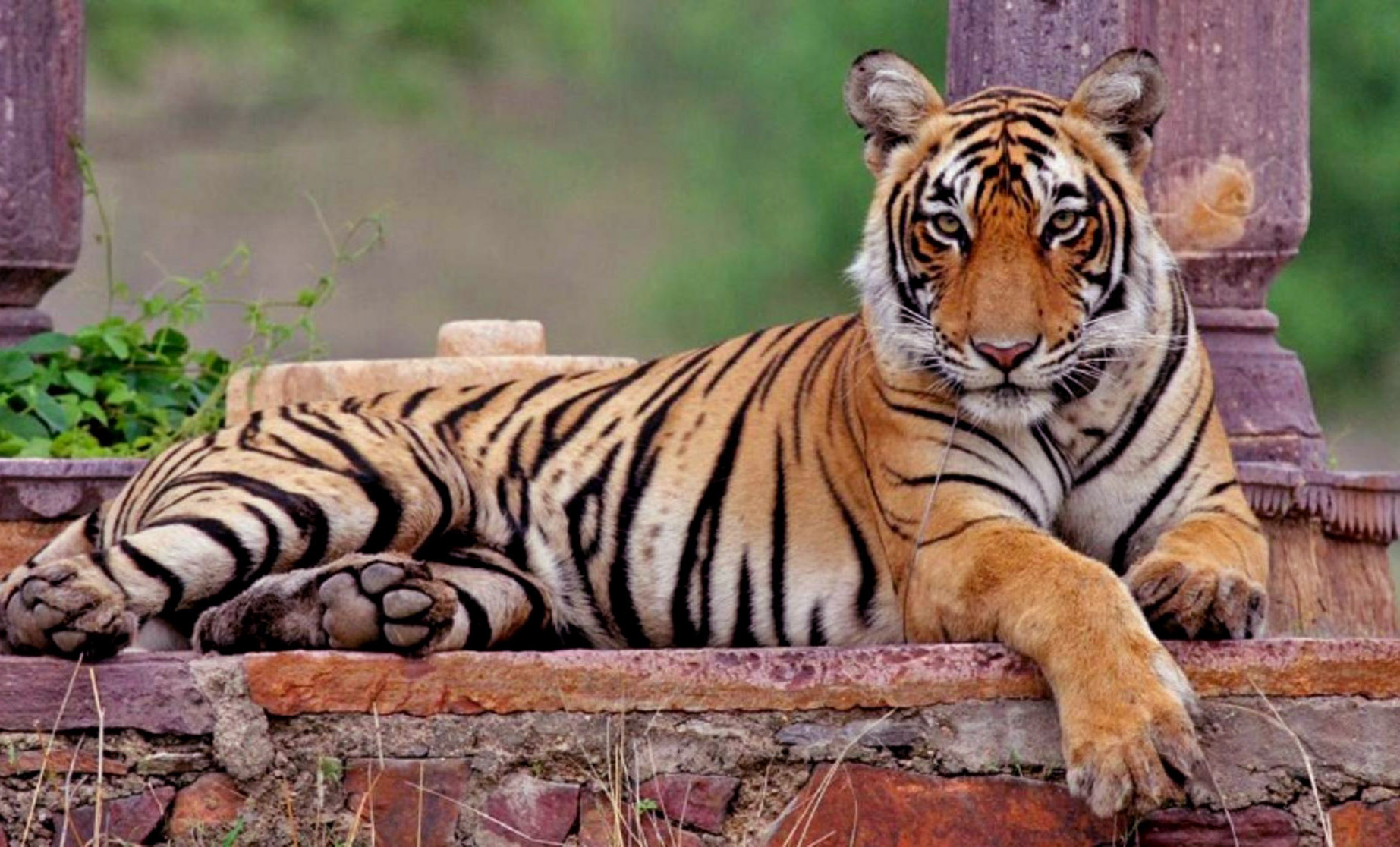In the dense mangroves of the Sundarbans, where saltwater laps at tangled roots, or along the sun-dappled riverbanks of Jim Corbett National Park, India’s tigers roam as emblems of a nation’s resolve. The 2022 census by the National Tiger Conservation Authority (NTCA) tallied 3,682 tigers—a range of 2,967 to 3,367—marking a 6.7% rise from 2,967 in 2018. This figure, representing 70% of the world’s wild tigers, is no mere statistic; it’s the result of decades of meticulous work, from government policies to village-level grit. On International Tiger Day we delve into India’s conservation saga and the storied lives of five tigers who embody its triumphs.
A CENTURY’S ARC
A hundred years ago, India’s forests thrummed with 20,000 to 40,000 tigers. By 1973, poaching, habitat loss, and dwindling prey had cut that number to a precarious 1,827. Enter Project Tiger, a bold initiative launched that year, which has since shepherded the population back to 3,167 by 2022. This rebound, spanning 53 reserves across 75,796.83 square kilometres in 18 states, reflects a web of strategies—legal protections, anti-poaching tech, community buy-in, and global alliances. Below, we unpack the machinery of this recovery and meet the tigers who’ve become its icons.
THE ENGINES OF CONSERVATION
PROJECT TIGER: A NATIONAL BACKBONE
Since 1973, Project Tiger, overseen by the NTCA, has been the cornerstone of India’s efforts. It manages 53 reserves, restores habitats, and relocates villages—over 1,200 families by 2023—to reduce human-tiger friction. The M-STrIPES system, with 32,717 camera traps, tracks tigers with precision, helping numbers climb from 1,411 in 2006 to 3,167 in 2022. In 2024, boosted funding targeted 32 critical corridors, like Kanha-Pench, to ensure tigers can roam freely between reserves.
NATIONAL TIGER CONSERVATION AUTHORITY
The NTCA is the nerve center, coordinating policies, conducting censuses every four years, and deploying the Special Tiger Protection Force in 13 reserves. Poaching has plummeted—only five cases in 2024—thanks to vigilant monitoring. The authority also regulates eco-tourism, balancing visitor access with habitat preservation.
INTERNATIONAL BIG CAT ALLIANCE
Launched in 2024, the India-based International Big Cat Alliance (IBCA) fosters global collaboration. It shares anti-poaching tech, trains rangers, and focuses on hotspots like the Sundarbans, where tigers navigate a labyrinth of tidal channels.
LEGAL AND COMMUNITY SAFEGUARDS
The Wildlife Protection Act of 1972, amended in 2022, lists tigers as Schedule I species, enforcing strict penalties—12 tiger skins were seized between 2023 and 2024. Community programs, like Eco-Development Committees in over 40 reserves, offer locals jobs in ecotourism, while compensation of Rs. 10–15 lakh for human fatalities has cut conflict by 20% in places like Pench since 2018.
ANTI-POACHING AND REINTRODUCTION
Drones, sniffer dogs, and satellite surveillance in reserves like Sundarbans and Kaziranga have slashed poaching. Meanwhile, reintroduction programs have moved tigers to Mukundra Hills (three by 2024) and Sanjay-Dubri, though efforts in Satkosia and Sahyadri face hurdles.
NGO AND PUBLIC SUPPORT
WWF-India bolsters 20 reserves, the Wildlife Trust of India has rehabilitated over 50 tigers since 2015, and the Global Tiger Forum aids cross-border efforts. Public campaigns like “Save Our Tigers” and “Roaring Together” in 2024, alongside eco-tourism generating Rs. 200 crore yearly, keep the momentum alive.
THE LEGENDARY TIGERS THAT DEFINE A MOVEMENT
Beyond the numbers, India’s tigers carry stories that resonate far beyond their forests. Here are five whose lives illuminate the stakes of conservation.
Machli – The Queen of Ranthambore
Born in 1997 in Ranthambore, Rajasthan, Machli ruled for 19 years. She famously killed a 14-foot mugger crocodile to protect her cubs and raised 11 across five litters, cementing Ranthambore’s tiger lineage. Her star power drew tourists, generating Rs. 60 crore annually for conservation. When she died in 2016, Machli left an indelible mark as Project Tiger’s poster child.

Collarwali – Supermom of Pench
In Pench Tiger Reserve, Madhya Pradesh, Collarwali—named for her radio collar—starred in BBC’s Tiger: Spy in the Jungle (2008). She birthed a record 29 cubs across eight litters, fuelling Pench’s population growth. Her calm presence around humans made her a conservation ambassador until her death in 2022.

Bamera – The Gentle King of Bandhavgarh
In Bandhavgarh National Park, Madhya Pradesh, Bamera, son of tigress Chakradhara, fathered at least 15 cubs with a serene authority. His tranquil patrols helped maintain the park’s 135 tigers (2022). Bamera’s death in 2016 from natural causes left a legacy of balance.

Parwali – The Tree-Climbing Tigress of Corbett
At Jim Corbett National Park, Uttarakhand, Parwali, or Pedwali (“tree-dweller”), charms visitors with her tree-climbing antics and riverside strolls along the Ramganga. Her poise, often captured with cubs, thrives in Corbett’s 260-tiger stronghold, India’s largest reserve population.

Mausi Maa – The Nurturing Tigress of Sanjay
In Sanjay Tiger Reserve, Madhya Pradesh, T28, dubbed Mausi Maa (“aunt-mother”), adopted three orphaned cubs after her sister’s death in a train accident. Raising seven cubs total, her devotion underscores the familial bonds that sustain tiger populations.

Arrowhead – The Bold Heir of Ranthambore
Born in 2014 in Ranthambore, Arrowhead (T-84), Machli’s granddaughter, ruled Zones 2–4 with her distinctive arrow-shaped facial mark. She birthed four litters, though only her 2019 cubs, Riddhi and Siddhi, survived. Despite battling bone cancer and a brain tumour and being ousted by Riddhi, Arrowhead’s cubs repopulated reserves. Her death on June 19, 2025, marked the end of a storied chapter.

A FUTURE FORGED IN FORESTS
India’s climb from 1,827 tigers in 1973 to 3,167 in 2022 reflects a rare conservation success. Project Tiger’s sprawling reserves, NTCA’s rigorous oversight, and innovations like drone surveillance and corridor restoration form a robust framework. Community programmes and global partnerships, like the IBCA, tackle persistent threats—habitat loss, poaching, human conflict. The lives of Machli, Collarwali, Bamera, Paarwali, Mausi Maa, and Arrowhead remind us that each tiger is more than a number; they are threads in a tapestry of survival, woven by a nation determined to protect its wild heart.

































